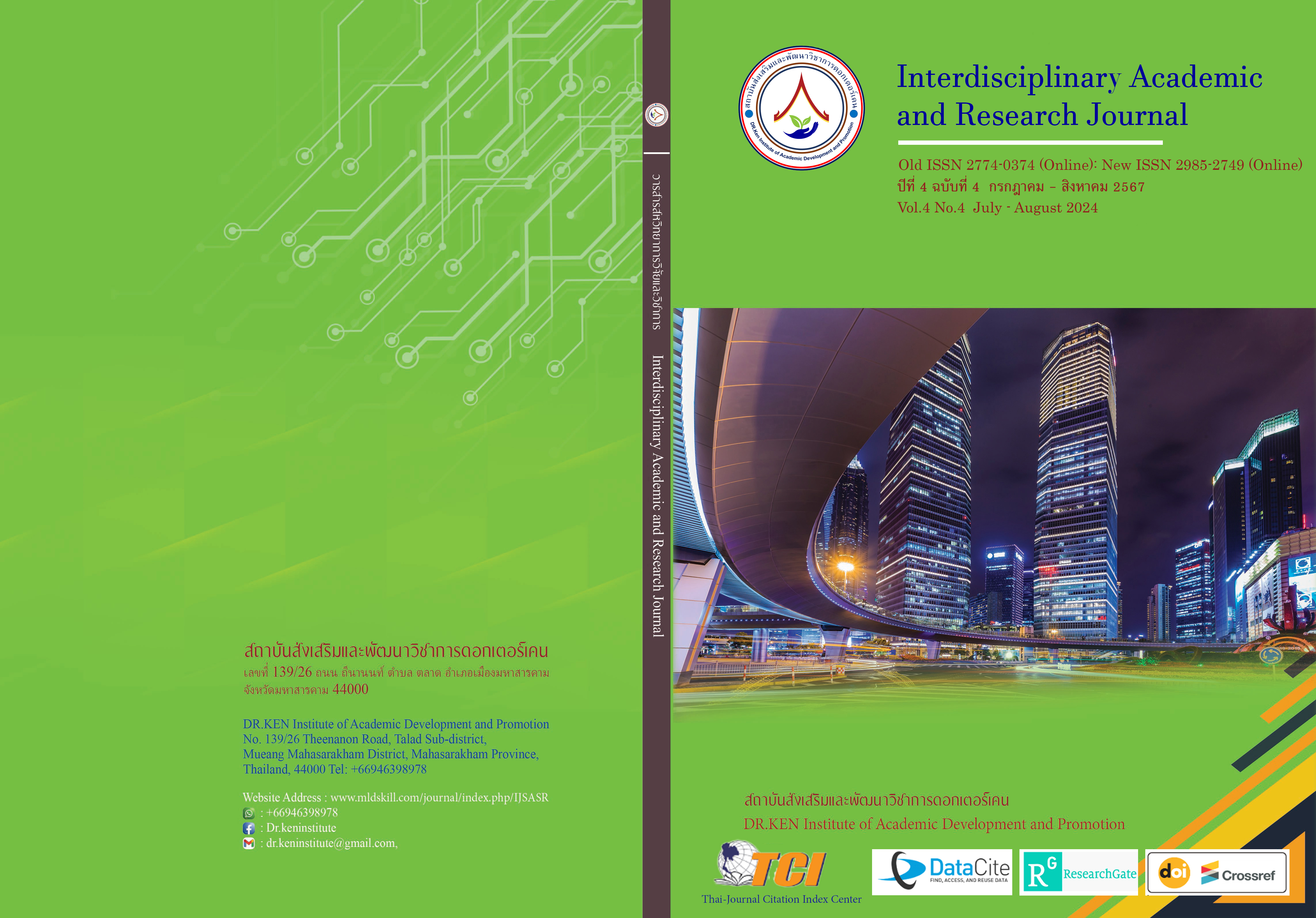Factors Associated with the Opinion on Self-Care of Elderly in Southernmost Provinces, Thailand
DOI:
https://doi.org/10.60027/iarj.2024.277038Keywords:
Opinion; , Elderly; , Self-care; , Southernmost of ThailandAbstract
Background and Aims: Self-care is crucial for the elderly since it allows everyone to have a healthy life, boost immunity, prevent sickness, care for themselves when unwell, and continue to perform everyday duties in their own homes. This study aimed to investigate the factors influencing the elderly's opinions on self-care in the southernmost provinces of Thailand.
Methodology: This quantitative study used data collected by the Deep South Coordination Center from 271 elderly people in Pattani. The independent variable included demographic factors and health conditions. The outcome variable was a 4-point rating scale opinion on the self-care of the elderly. Descriptive statistics were employed to illustrate the sample's characteristics. Factor analysis was used to reduce the number of outcome variables. Multiple linear regression was used to examine the relationship between the outcome variables and the independent variables.
Results: Eighteen outcome variables were categorized into three factors consisting of positive self-management, health preparation, and doing things for great pleasure. Elderly people who could walk with their spouse or family were more likely to have positive self-management and health preparation than those who lived alone or were separated and could not walk. Elderly people who did not engage in health-risk activities and could use public transportation independently were more likely to enjoy themselves than those who could not.
Conclusion: The findings might improve the quality of self-care among the elderly to live better in their current societal situation. This can encourage care healthcare providers to promote daily living practices among the elderly.
References
Backman, K., & Hentinen, M. (2001). Factors associated with the self‐care of home‐dwelling elderly. Scandinavian Journal of Caring Sciences, 15(3), 195-202.
Cadmus, E.O., Adebusoye, L.A., & Owoaje, E.T. (2021). Attitude towards aging and perceived health status of community-dwelling older persons in a low resource setting: a rural-urban comparison. BMC geriatrics, 21(1), 1-11.
Ford, K., Jampaklay, A., & Chamratrithirong, A. (2021). A Multilevel Longitudinal Study of Individual, Household, and Village Factors Associated with Happiness Among Adults in the Southernmost Provinces of Thailand. Applied Research in Quality of Life, 17(3), 1459–1476. https://doi.org/10.1007/s11482-021-09973-z
Hair, J.F., Black, W.C., Babin, B.J., & Anderson, R.E (2009). Multivariate Data Analysis. "Seventh". Prentice Hall, Upper Saddle River, New Jersey.
Hancock, N., Scanlan, J.N., Bundy, A.C., & Honey, A. (2019). Recovery Assessment Scale – Domains & Stages (RAS‐DS) Manual‐ Version 3. Sydney; University of Sydney.
National Statistical Office. (2007). Report on the 2007 survey of the older persons in Thailand. Bureau of Socio-Economic and Opinion 1, Bangkok.
Techataweewan, W., & Prasertsin, U. (2017). Development of digital literacy indicators for Thai undergraduate students using mixed method research. Kasetsart Journal of Social Sciences. 39 (2), 215-221. 10.1016/j.kjss.2017.07.001.
Räsänen, P., Kanste, O., Elo, S., & Kyngäs, H. (2014). Factors associated with the self-care of home-dwelling older people. Journal of Nursing Education and Practice, 4(8), 90-96. DOI: https://doi.org/10.5430/jnep.v4n8p90
Riebe, D., Blissmer, B.J., Greaney, M.L., Garber, C.E., Lees, F.D., & Clark, P.G. (2009). The relationship between obesity, physical activity, and physical function in older adults. Journal of Aging Health. 2009;21(8):1159–1178.
Sadegh, M., Moftakhari Rostamkhani, H., Gupta, H., Ragno, E., Mazdiyasni, O., Sanders, B., Matthew, R., & AghaKouchak, A. (2018). Multihazard Scenarios for Analysis of Compound Extreme Events. Geophysical Research Letters. 45 (2), 5470-5480. https://doi.org/10.1029/2018GL077317
Sinsirimana, S. (2003). Health promotion experiences Thai elders. Degree of Master Nursing Science in Nursing. Chulalongkorn University, Thailand.
TGRI: Institute for Population and Social Research, Mahidol University and Foundation of Thai Gerontology Research and Development Institute. (2020). The situation of the Thai Elderly 2019. Printery Co., Nakorn Pathom.
Thanakwang, K., Isaramalai, S., & Hatthakit, U. (2014). Thai Cultural Understandings of Active Ageing from the Perspectives of Older Adults: A Qualitative Study. Pacific Rim International Journal of Nursing Research, 18(2), 152-165
Thanakwang, K., Soonthorndhada, K., & Mongkolprasoet, J. (2012). Perspectives on healthy aging among Thai elderly: A qualitative study. Nursing & Health Sciences, 14(4), 472–479. https://doi.org/10.1111/j.1442-2018.2012.00718.x
Tuna, H.D., Edeer, A.O., Malkoc, M., & Aksakoglu, G. (2009). Effect of age and physical activity level on functional fitness in older adults. European Review of Aging and Physical Activity, 6, 99–106.
United Nations. (2020). (2020). World Population Ageing 2019 (ST/ESA/SER.A/444). Department of Economic and Social Affairs, Population Division.
Yansopon, S. (2021). A Study of Health Behaviors of Pre-Aging Groups in Preparing for Entering an Aging Society of the 2nd Health Zone. Journal of Department of Health Service Support, 17(3), 56-68.
Yatniyom, P. (2004). Active aging attribution: a case study of elite Thai elderly. Master of Nursing Science, Thesis. Chulalongkon University.Thailand.
Zeleznik D. (2007). Self-care of the home-dwelling elderly people living in Slovenia. PhD thesis. University of Oulu, Department of Nursing and Health Administration. Retrieved from: http://herkules.oulu.fi/isbn9789514286377/isbn9789514286377.pdf
Downloads
Published
How to Cite
Issue
Section
License
Copyright (c) 2024 Interdisciplinary Academic and Research Journal

This work is licensed under a Creative Commons Attribution-NonCommercial-NoDerivatives 4.0 International License.
Copyright on any article in the Interdisciplinary Academic and Research Journal is retained by the author(s) under the under the Creative Commons Attribution-NonCommercial-NoDerivatives 4.0 International License. Permission to use text, content, images, etc. of publication. Any user to read, download, copy, distribute, print, search, or link to the full texts of articles, crawl them for indexing, pass them as data to software, or use them for any other lawful purpose. But do not use it for commercial use or with the intent to benefit any business.
















.png)


